First Results on Moss Biomonitoring of Trace Elements in the Central Part of Georgia, Caucasus
Abstract
1. Introduction
2. Experimental
2.1. Study Area
2.2. Moss Sampling
2.3. Sample Preparation and Elemental Analysis
2.4. Quality Control of ENAA and AAS
2.5. Data Analysis Using PCA
2.6. Construction of GIS Maps
3. Results and Discussion
4. Conclusions
Author Contributions
Funding
Data Availability Statement
Acknowledgments
Conflicts of Interest
References
- Cohen, A.; Brauer, M.; Burnett, R.; Anderson, H.R.; Frostad, J.; Estep, K.; Balakrishnan, K.; Brunekreef, B.; Dandona, L.; Dandona, R.; et al. Estimates and 25-year trends of the global burden of disease attributable to ambient air pollution: An analysis of data from the Global Burden of Diseases Study 2015. Lancet 2017, 389, 1907–1918. [Google Scholar] [CrossRef]
- Directive 2004/107/EC of the European parliament and of the council of 15 December 2004 relating to arsenic, cadmium, mercury, nickel and polycyclic aromatic hydrocarbons in ambient air. Off. J. Eur. Union 2005, 23, 1–16.
- Directive2008/50/EC of the European parliament and of the council of 21 May 2008 on ambient air and cleaner air for Europe. Off. J. Eur. Union 2008, 152, 1–44.
- Markert, B.A.; Breure, A.M.; Zechmeister, H.G. Definitions, strategies and principles for bioindications/biomonitoring of the environment. In Bioindicators & Biomonitors; Markert, B.A., Breure, A.M., Zechmeister, H.G., Eds.; Elsevier Science Ltd.: Amsterdam, The Netherlands, 2003; pp. 3–41. [Google Scholar]
- Frontasyeva, M.; Harmens, H.; Uzhinskiy, A.; Chaligava, O.; Participants of the Moss Survey. Mosses as Biomonitors of Air Pollution: 2015/2016 Survey on Heavy Metals, Nitrogen and POPs in Europe and beyond; Report of the ICP Vegetation Moss Survey Coordination Centre; Joint Institute for Nuclear Research: Dubna, Russian, 2020; p. 136. ISBN 978-5-9530-0508-1. [Google Scholar]
- Shetekauri, L.S.; Shetekauri, T.; Kvlividze, A.; Chaligava, O.; Kalabegeshvili, T.; Kirkesali, E.I.; Frontasyeva, M.V.; Chepurchenko, O.E. Preliminary results of atmospheric deposition of major and trace elements in the Greater and Lesser Caucasus Mountains studied by the moss technique and neutron activation analysis. Ann. Bot. 2015, 89–95. [Google Scholar] [CrossRef]
- Shetekauri, S.; Chaligava, O.; Shetekauri, T.; Kvlividze, A.; Kalabegishvili, T.; Kirkesali, E.; Frontasyeva, M.V.; Chepurchenko, O.E.; Tselmovich, V.A. Biomonitoring air pollution with moss in Georgia. Polish J. Environ. Stud. 2018, 27, 2259–2266. [Google Scholar] [CrossRef]
- Chaligava, O.; Shetekauri, S.; Badawy, W.M.; Frontasyeva, M.V.; Zinicovscaia, I.; Shetekauri, T.; Kvlividze, A.; Vergel, K.; Yushin, N. Trace elements in atmospheric deposition studied by moss biomonitoring using neutron activation analysis and atomic absorption spectrometry in Georgia: Characteristics and impacts. Arch. Environ. Contam. Toxicol. 2020. [Google Scholar] [CrossRef]
- Van Westen, C.J.; Straatsma, M.; Turdukulov, U.; Feringa, W.F.; Sijmons, K.; Bakhtadze, K.; Janelidze, T.; Kheladze, N. Atlas of Natural Hazards and Risk in Georgia; CENN Caucasus Environmental NGO Network: Tbilisi, Georgia, 2012; ISBN 978-9941-0-4310-9. (In Georgian) [Google Scholar]
- UNISDR (United Nations Office for Disaster Risk Reduction). Central Asia and Caucasus Disaster Risk Management Initiative (CAC DRMI). Risk Assessment for Central Asia and Caucasus: Desk Study Review; The United Nations Office for Disaster Risk Reduction: Geneva, Switzerland, 2009. (In Russian) [Google Scholar]
- Gulisashvili, V.Z. Natural Zones and Natural-Historical Regions of the Caucasus; Nauka: Moscow, Russia, 1964; 327p. (In Russian) [Google Scholar]
- Melikishvili, G.A.; Lordkipanidze, O.D.; Academy of Sciences of the Georgian SSR. Essays on the history of Georgia. In Javakhishvili Institute of History, Archeology and Ethnography. Date of Admission to EC 27.02.2002; Metsniereba: Tbilisi, Georgia, 1989; Volume 8. (In Russian) [Google Scholar]
- Special Report—“Right to Clean Air (Air Quality in Georgia)”. Public Defender (Ombudsman) of Georgia. Available online: https://www.ombudsman.ge/geo/spetsialuri-angarishebi/190627034307spetsialuri-angarishi-ufleba-sufta-haerze-atmosferuli-haeris-khariskhi-sakartveloshi (accessed on 30 December 2020).
- Gurguliani, I. Arsenic Contamination in Georgia, Environment Related Security Risks from old Soviet Legacy. In Proceedings of the 22nd OSCE Economic and Environmental Forum “Responding to Environmental Challenges with a View to Promoting Cooperation and Security in the OSCE Area”, Vienna, Austria, 27–28 January 2014; Available online: https://www.osce.org/files/f/documents/a/a/110702.pdf (accessed on 30 December 2020). (In Russian).
- Alfthan, B. Outlook on Climate Change Adaptation in the South Caucasus Mountains—2016. 2016. Available online: https://www.weadapt.org/sites/weadapt.org/files/2017/june/caucasus_smd.pdf (accessed on 30 December 2020). (In Russian).
- Moss Manual “Heavy Metals, Nitrogen and POPs in European Mosses: 2020 Survey”. Available online: https://icpvegetation.ceh.ac.uk/sites/default/files/ICP%20Vegetation%20moss%20monitoring%20manual%202020.pdf (accessed on 30 December 2020).
- Pavlov, S.S.; Dmitriev, A.Y.; Chepurchenko, I.A.; Frontasyeva, M.V. Automation system for measurement of gamma-ray spectra of induced activity for neutron activation analysis at the reactor IBR-2 of Frank Laboratory of Neutron Physics at the Joint Institute for Nuclear Research. Phys. Elem. Part Nucl. 2014, 11, 737–742. Available online: https://link.springer.com/article/10.1134/S1547477114060107 (accessed on 30 December 2020). [CrossRef]
- Schaug, J.; Rambaek, J.P.; Steinnes, E.; Henry, R. Multivariate Analysis of Trace Element Data from Moss Samples Used to Monitor Atmospheric Deposition. Atmos. Environ. 1990, 24A, 2625–2631. [Google Scholar] [CrossRef]
- Stafilov, T.; Šajn, R.; Barandovski, L.; Andonovska, K.B.; Malinovska, S. Moss biomonitoring of atmospheric deposition study of minor and trace elements in Macedonia. Air Qual. Atmos. Health 2018, 11, 137–152. [Google Scholar] [CrossRef]
- Hristozova, G.; Marinova, S.; Svozilík, V.; Nekhoroshkov, P.; Frontasyeva, M.V. Biomonitoring of elemental atmospheric deposition: Spatial distributions in the 2015/2016 moss survey in Bulgaria. J. Radioanal. Nucl. Chem. 2019. [Google Scholar] [CrossRef]
- Steinnes, E.; Uggerud, H.T.; Pfaffhuber, K.A.; Berg, T. Atmospheric Deposition of Heavy Metals in Norway; National Moss Survey 2015; NILU—Norwegian Institute for Air Research: Kjeller, Norway, 2016; p. 55. [Google Scholar]
- Frontasyeva, M.V.; Steinnes, E. Marine gradients of halogens in moss studied by epithermal neutron activation analysis. J. Radioanal. Nucl. Chem. 2004, 261, 101–106. [Google Scholar] [CrossRef]
- Kabata-Pendias, A. Trace Elements in Soils And Plants, 4th ed.; CRC Press/Taylor & Francis Group: Boca Raton, FL, USA, 2010; ISBN 9780429192036,. [Google Scholar] [CrossRef]
- Nriagu, J.O. A global assessment of natural sources of atmospheric trace metals. Nature 1989, 338, 47–49. [Google Scholar] [CrossRef]
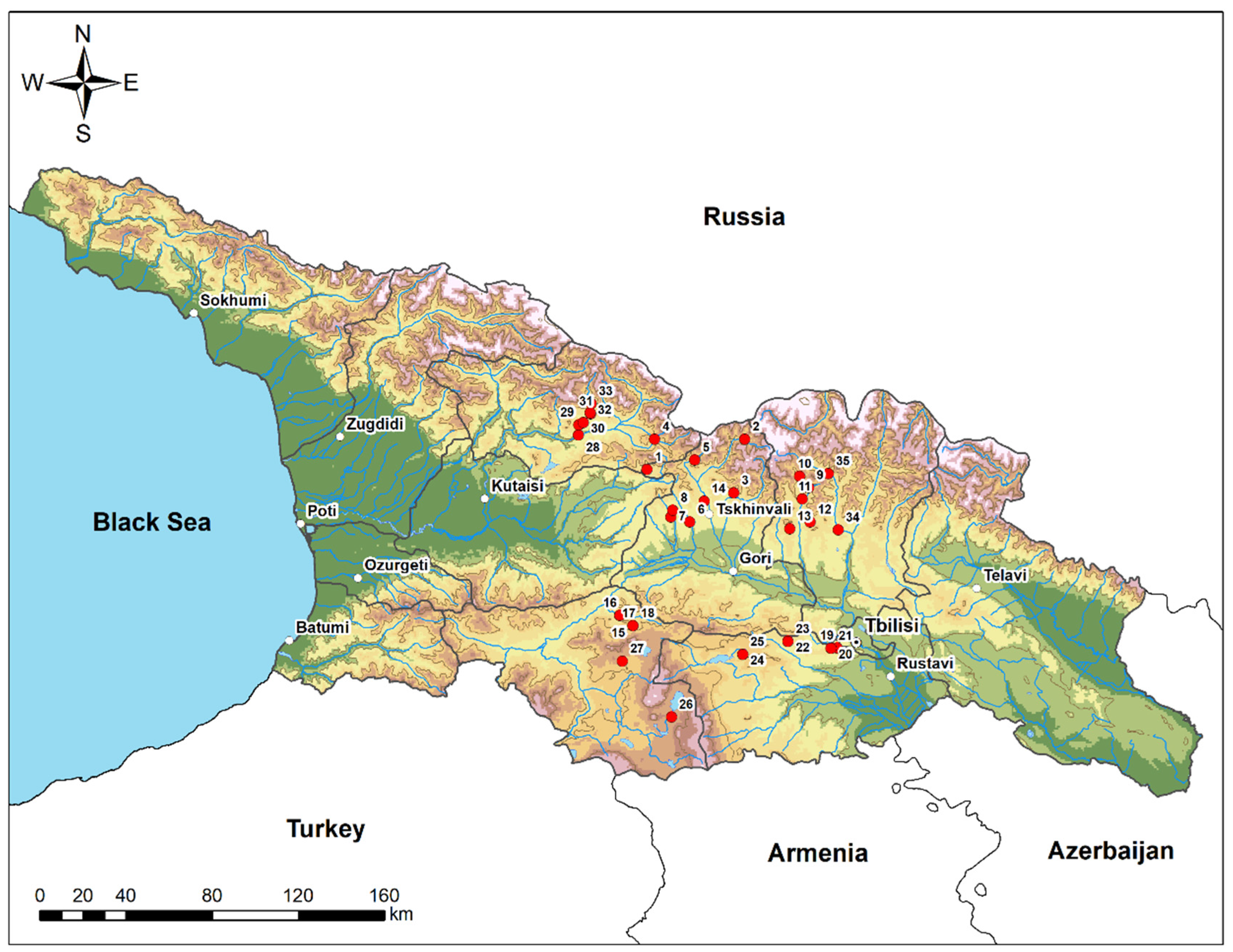
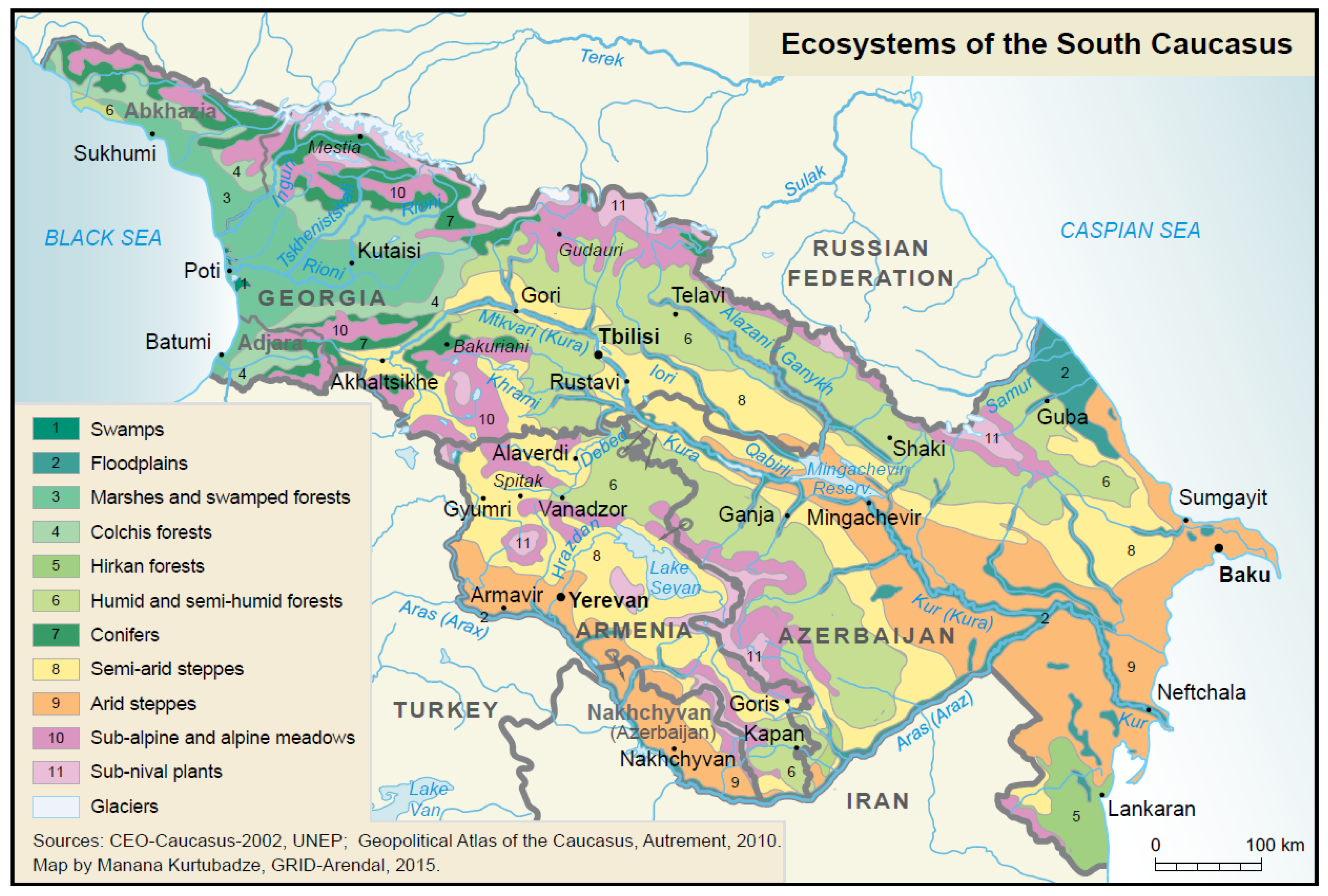

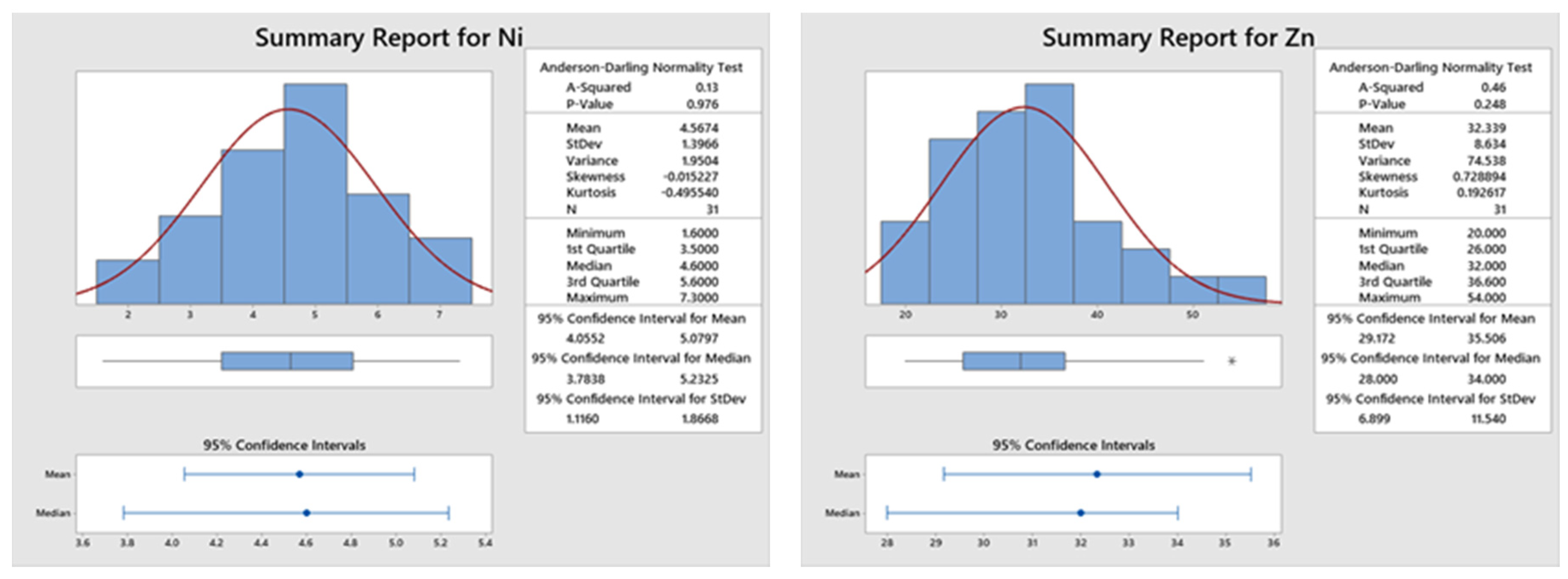
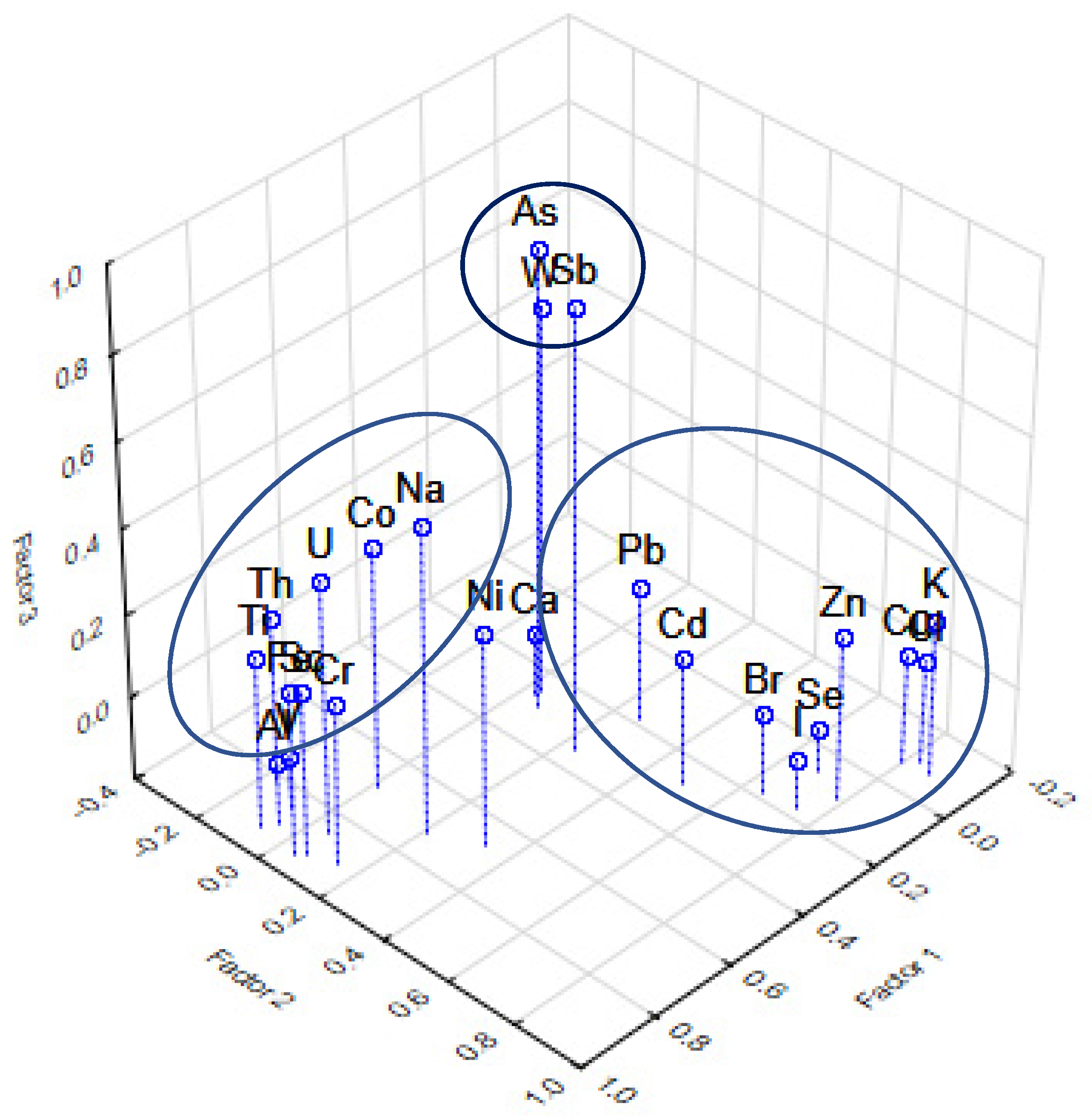
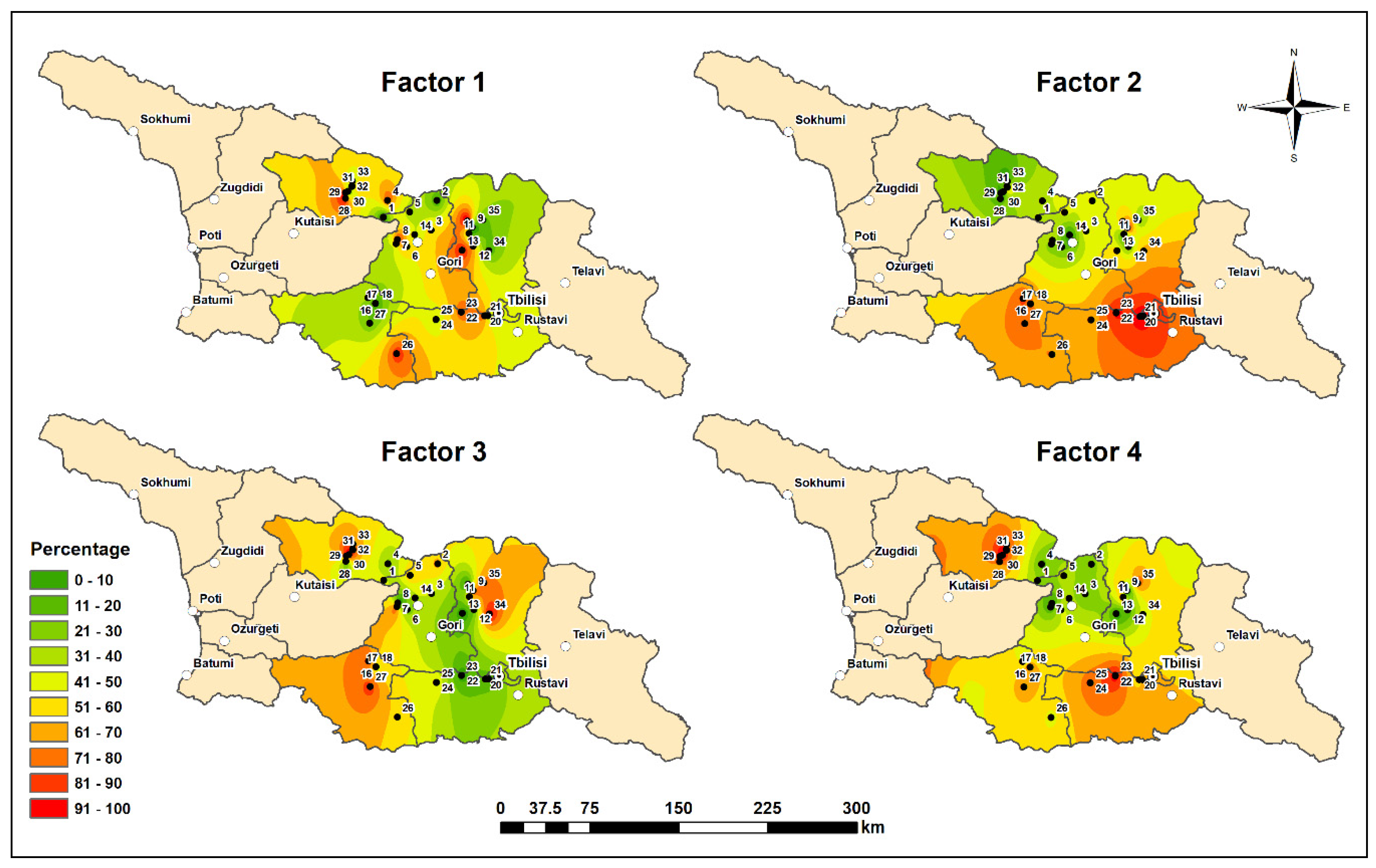
| SRM | Sample | Element | Obtained | Certified | SRM | Sample | Element | Obtained | Certified |
|---|---|---|---|---|---|---|---|---|---|
| 2709a | FFA1 | Na | 21,647 ± 1602 | 21,900 ± 811 | FFA1 | 2709a | Rb | 100.4 ± 16.6 | 99.00 ± 2.97 |
| 1547 | 1575a | Mg | 1086.5 ± 59.8 | 1060 ± 170 | FFA1 | 2709a | Sr | 239.8 ± 21.1 | 239.00 ± 5.98 |
| 1632c | 1633c | Al | 133,841 ± 4016 | 132,800 ± 6109 | 2709a | 1632c | Zr | 18.31 ± 4.86 | 16.0 ± 4.8 |
| 1549 | 1632c | Cl | 1120 ± 77 | 1139 ± 41 | 2709a | FFA1 | Sb | 17.92 ± 3.79 | 17.6 ± 2.5 |
| 2709a | FFA1 | K | 22,498 ± 1373 | 22,000 ± 6600 | 1549 | 1547 | I | 0.394 ± 0.099 | 0.30 ± 0.09 |
| 1633c | 2709a | Ca | 19,711 ± 1814 | 19,100 ± 898 | 2709a | 667 | Cs | 7.9 ± 0.3 | 7.80 ± 0.71 |
| 2709a | 667 | Sc | 13.82 ± 0.35 | 13.7 ± 0.7 | 2709a | 1632c | Ba | 41.83 ± 6.03 | 41.1 ± 1.61 |
| 1633c | 2710a | Ti | 2928 ± 205 | 3110 ± 72 | 667 | 2709a | La | 21.26 ± 1.13 | 21.7 ± 0.4 |
| 1633c | 1632c | V | 22.79 ± 1.03 | 23.72 ± 0.53 | 667 | 2709a | Ce | 42.26 ± 2.79 | 42.00 ± 1.01 |
| FFA1 | 667 | Cr | 181.6 ± 11.9 | 178 ± 16 | 667 | FFA1 | Nd | 51.44 ± 6.49 | 56.8 ± 3.7 |
| 1575a | 1547 | Mn | 97.83 ± 5.97 | 98 ± 3 | 667 | 1632c | Sm | 1.021 ± 0.092 | 1.078 ± 0.029 |
| FFA1 | 2709a | Fe | 34,306 ± 1784 | 33,600 ± 706 | 667 | 2709a | Eu | 0.833 ± 0.067 | 0.83 ± 0.02 |
| 2709a | FFA1 | Co | 39.87 ± 1.36 | 39.8 ± 1.7 | 667 | FFA1 | Tb | 1.285 ± 0.047 | 1.38 ± 0.14 |
| 2709a | 1632c | Ni | 9.56 ± 0.76 | 9.32 ± 0.52 | FFA1 | 667 | Yb | 2.49 ± 0.23 | 2.200 ± 0.091 |
| 2709a | 667 | Zn | 177.11 ± 9.04 | 175 ± 13 | FFA1 | 1632c | Hf | 0.508 ± 0.047 | 0.585 ± 0.011 |
| FFA1 | 1632c | As | 6.07 ± 0.36 | 6.18 ± 0.28 | 667 | FFA1 | Ta | 1.774 ± 0.055 | 2.11 ± 0.17 |
| 1632c | 2709a | Se | 1.02 ± 0.18 | 1.5 ± 0.45 | FFA1 | 2709a | Th | 10.95 ± 0.43 | 10.9 ± 0.2 |
| 667 | 1632c | Br | 21.08 ± 0.85 | 18.7 ± 0.4 | 2709a | 1632c | U | 0.51 ± 0.03 | 0.52 ± 0.02 |
| Element | Certified | Obtained |
|---|---|---|
| Cd | 0.54 ± 0.02 | 0.54 ± 0.01 |
| Cu | 5.0 ± 0.10 | 4.6 ± 0.3 |
| Pb | 0.20 ± 0.06 | 0.18 ± 0.01 |
| Element | Georgia, 2019 Present Study | Georgia, 2014–2017 [8] | North Macedonia, 2015 [19] | Bulgaria, 2015/16 [20] | Norway, 2015 [21] | |||||
|---|---|---|---|---|---|---|---|---|---|---|
| n—number of samples | n = 35 | n = 120 | n = 72 | n = 115 | n = 229 | |||||
| Element | Median | Range | Median | Range | Median | Range | Median | Range | Median | Range |
| Na | 482 | 169–1350 | 581 | 101–3000 | 190 | 140–380 | 225 | 79–1560 | 210 | 60–800 |
| Mg | 2640 | 1910–4420 | 3060 | 1220–11600 | 1900 | 1200–3800 | 2080 | 514–8550 | 1350 | 470–3280 |
| Al | 2770 | 1610–9680 | 4295 | 759–24,500 | 2100 | 750–7400 | 2310 | 569–10,900 | 460 | 100–3050 |
| Cl | 132 | 56–635 | 185 | 57.3–1080 | ND | ND | 78.8 | 16.6–861 | ND | ND |
| K | 5930 | 3970–8860 | 5935 | 2030–15,000 | 6000 | 3100–14,000 | 5670 | 3250–14,200 | 3560 | 1770–6400 |
| Ca | 8400 | 5490–12,400 | 8255 | 4620–17,100 | 6900 | 3500–13,000 | 6630 | 606–14,200 | 3030 | 1820–7230 |
| Sc | 0.8 | 0.36–2.1 | 1.11 | 0.17–6.58 | ND | ND | 0.41 | 0.10–3.13 | 0.09 | 0.02–1.4 |
| Ti | 238 | 129–596 | 349.5 | 68.6–2100 | ND | ND | 143 | 46.4–764 | 24 | 6–152 |
| V | 6.5 | 3.85–16.2 | 9.4 | 1.71–54 | 3.3 | 0.47–11 | 3.89 | 1.3–22.7 | 1.2 | 0.3–14 |
| Cr | 6.6 | 3.14–15.5 | 7.75 | 14,337 | 5.7 | 11,536.00 | 2.73 | 0.219–25 | 0.7 | 0.2–17 |
| Mn | 142 | 64–377 | 141 | 230,306 | 160 | 33–510 | 180 | 39–551 | 400 | 40–1660 |
| Fe | 2410 | 1150–6110 | 2725 | 404–14,100 | 1700 | 510–4600 | 1190 | 376–7240 | 310 | 78–8125 |
| Co | 1 | 0.36–2.6 | 1.43 | 0.23–8.12 | 0.6 | 0.16–2 | 0.59 | 0.197–3.29 | 0.2 | 0.06–23 |
| Ni | 4.9 | 1.6–10.8 | 5.56 | 1.92–24.2 | 3.5 | 0.68–63 | 2.1 | 0.45–13.5 | 1.1 | 0.4–550 |
| Cu * | 8.93 | 6.58–13.7 | 5.54 | 0.13–143 | 4.6 | 3.0–8.3 | 7.36 | 3.2–46.88 | 4.2 | 1.8–370 |
| Zn | 32 | 20–54 | 28.85 | 7.15–75.2 | 30 | дек.66 | 28 | 9–101 | 31 | 8–409 |
| As | 0.58 | 0.27–27.6 | 1.05 | 0.18–83.3 | 0.54 | 0.13–1.4 | 0.45 | 0.20–3.57 | 0.13 | 0.04–4.72 |
| Se | 0.18 | 0.09–0.37 | 0.23 | 0.068–0.65 | ND | ND | 0.2 | 0.008–0.67 | 0.3 | 0.009–2 |
| Br | 4.4 | 1.84–8.1 | 6.31 | 2.33–25.2 | ND | ND | 2.8 | 1.2–9.4 | ND | ND |
| Rb | 7.2 | 4.1–16.4 | 10.55 | 2.92–34.2 | 5.3 | 02.02.2028 | 7.38 | 2.24–50.7 | 12.4 | 1.4–81 |
| Sr | 37.6 | 24–68 | 43.85 | 17.2–157 | 25 | 6.5-220 | 25 | 11.3–122 | 13.6 | 3.8–60 |
| Zr | 9.4 | 3.5–25 | 10.55 | 1.19–67.9 | ND | ND | ND | ND | ND | ND |
| Mo | 0.57 | 0.37–6.3 | 0.35 | 0.14–2.1 | 0.17 | 0.08–0.51 | ND | ND | ND | ND |
| Cd * | 0.12 | 0.058–0.35 | 5.57 | 0.01–0.58 | 0.23 | 0.018–0.88 | 0.1 | 0.02–1.56 | 0.08 | 0.02–1.33 |
| Sb | 0.13 | 0.07–0.72 | 0.15 | 0.049–1.36 | ND | ND | 0.11 | 0.04–0.51 | 0.07 | 0.007–0.38 |
| I | 2.04 | 1.14–4.35 | 0.16 | 0.58–11.8 | ND | ND | 1.28 | 0.48–2.99 | ND | ND |
| Cs | 0.263 | 0.16–0.97 | 2.48 | 0.036–2.67 | ND | ND | 0.207 | 0.0716–1.8 | 0.16 | 0.02–1.63 |
| Ba | 37 | 17–100 | 0.42 | 4.98–365 | 42 | 9.7–180 | 46 | 14.2–309 | 25 | 5.3–130 |
| La | 1.57 | 0.82–6.2 | 51.3 | 0.34–12 | ND | ND | 1.35 | 0.39–22.6 | 0.32 | 0.07–3.5 |
| Ce | 2.97 | 1.38–9.2 | 2.15 | 0.31–21.7 | ND | ND | 2.4 | 0.5–29.2 | 0.61 | 0.10–4.78 |
| Nd | 1.73 | 0.87–7.6 | 3.75 | 0.45–10.7 | ND | ND | 1.3 | 0.2–24.1 | 0.23 | 0.01–2.24 |
| Sm | 0.26 | 0.12–1.17 | 2.04 | 0.031–2.7 | ND | ND | ND | ND | 0.05 | 0.004–0.38 |
| Eu | 0.054 | 0.02–0.22 | 0.34 | 0.023–0.52 | ND | ND | 0.07 | 0.009–0.92 | 0.04 | 0.01–0.19 |
| Tb | 0.04 | 0.02–0.15 | 0.1 | 0.011–0.31 | ND | ND | 0.03 | 0.005–0.42 | 0.01 | <0.001–0.09 |
| Yb | 0.15 | 0.054–0.51 | 0.05 | 0.022–0.8 | ND | ND | 0.1 | 0.03–1.08 | 0.003 | <0.001–0.016 |
| Hf | 0.24 | 0.11–0.76 | 0.15 | 0.041–1.81 | ND | ND | 0.16 | 0.04–1.44 | ND | ND |
| Ta | 0.046 | 0.02–0.13 | 0.27 | 0.0069–0.28 | ND | ND | 0.04 | 0.009–0.28 | ND | ND |
| W | 0.14 | 0.04–0.41 | 0.06 | 0.026–0.67 | ND | ND | 0.1 | 0.02–1.44 | ND | ND |
| Pb * | 4.33 | 2.34–8.21 | 0.11 | 0.18–9.1 | 4.9 | 2.2–14 | 10.7 | 3.72–102.8 | 0.05 | 0.001–0.4 |
| Th | 0.45 | 0.18–1.57 | 0.51 | 0.063–2.9 | ND | ND | 0.39 | 0.09–2.8 | 0.03 | 0.007–1.5 |
| U | 0.12 | 0.06–0.34 | 0.16 | 0.021–1.25 | ND | ND | 0.12 | 0.03–3.2 | 0.006 | 0.002–0.08 |
| Variable | Factor 1 | Factor 2 | Factor 3 | Factor 4 | Communality |
|---|---|---|---|---|---|
| Na | 0.72 | 0.21 | 0.53 | 0.21 | 0.98 |
| Al | 0.82 | −0.16 | −0.15 | −0.43 | 1.00 |
| Cl | −0.10 | 0.83 | 0.04 | 0.19 | 0.92 |
| K | −0.08 | 0.87 | 0.18 | −0.06 | 0.81 |
| Ca | 0.27 | 0.03 | -0.05 | −0.80 | 0.80 |
| Sc | 0.93 | 0.07 | 0.19 | 0.14 | 1.00 |
| Ti | 0.93 | −0.07 | 0.21 | −0.12 | 0.98 |
| V | 0.86 | −0.07 | −0.07 | −0.30 | 0.99 |
| Cr | 0.90 | 0.14 | 0.18 | 0.19 | 0.99 |
| Fe | 0.94 | 0.05 | 0.20 | 0.11 | 1.00 |
| Co | 0.69 | 0.01 | 0.38 | 0.28 | 0.94 |
| Ni | 0.67 | 0.34 | 0.32 | 0.40 | 0.97 |
| Zn | 0.10 | 0.78 | 0.20 | −0.12 | 0.83 |
| As | 0.30 | 0.07 | 0.89 | −0.12 | 0.97 |
| Se | 0.07 | 0.69 | −0.09 | 0.54 | 0.92 |
| Br | 0.19 | 0.65 | 0.00 | 0.65 | 0.94 |
| Sb | 0.34 | 0.24 | 0.85 | 0.00 | 0.98 |
| I | 0.18 | 0.74 | −0.08 | 0.54 | 0.96 |
| Th | 0.90 | −0.05 | 0.29 | 0.06 | 0.89 |
| U | 0.85 | 0.05 | 0.41 | 0.15 | 1.00 |
| Cd | 0.27 | 0.49 | 0.10 | 0.64 | 1.00 |
| Pb | 0.19 | 0.26 | 0.12 | 0.71 | 0.91 |
| Cu | −0.07 | 0.80 | 0.06 | 0.27 | 0.92 |
| W | 0.26 | 0.03 | 0.72 | 0.32 | 0.84 |
| Expl.Var | 8.39 | 4.75 | 3.10 | 3.49 | 19.72 |
| Prp.Totl | 0.35 | 0.20 | 0.13 | 0.15 | 0.82 |
Publisher’s Note: MDPI stays neutral with regard to jurisdictional claims in published maps and institutional affiliations. |
© 2021 by the authors. Licensee MDPI, Basel, Switzerland. This article is an open access article distributed under the terms and conditions of the Creative Commons Attribution (CC BY) license (http://creativecommons.org/licenses/by/4.0/).
Share and Cite
Chaligava, O.; Nikolaev, I.; Khetagurov, K.; Lavrinenko, Y.; Bazaev, A.; Frontasyeva, M.; Vergel, K.; Grozdov, D. First Results on Moss Biomonitoring of Trace Elements in the Central Part of Georgia, Caucasus. Atmosphere 2021, 12, 317. https://doi.org/10.3390/atmos12030317
Chaligava O, Nikolaev I, Khetagurov K, Lavrinenko Y, Bazaev A, Frontasyeva M, Vergel K, Grozdov D. First Results on Moss Biomonitoring of Trace Elements in the Central Part of Georgia, Caucasus. Atmosphere. 2021; 12(3):317. https://doi.org/10.3390/atmos12030317
Chicago/Turabian StyleChaligava, Omari, Igor Nikolaev, Khetag Khetagurov, Yulia Lavrinenko, Anvar Bazaev, Marina Frontasyeva, Konstantin Vergel, and Dmitry Grozdov. 2021. "First Results on Moss Biomonitoring of Trace Elements in the Central Part of Georgia, Caucasus" Atmosphere 12, no. 3: 317. https://doi.org/10.3390/atmos12030317
APA StyleChaligava, O., Nikolaev, I., Khetagurov, K., Lavrinenko, Y., Bazaev, A., Frontasyeva, M., Vergel, K., & Grozdov, D. (2021). First Results on Moss Biomonitoring of Trace Elements in the Central Part of Georgia, Caucasus. Atmosphere, 12(3), 317. https://doi.org/10.3390/atmos12030317









